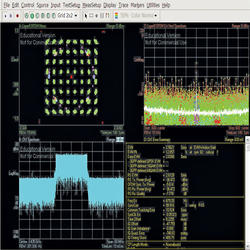Vector Network Analyzer
Vector network analyzer (VNA) is one of the most essential RF and microwave measurement instrument. VNA is commonly used to measure the scattering parameters, or S parameters of radio frequency (RF) and microwave devices like filter, amplifier, circulator etc. The information provided by the vector network analyzer, VNA is then used to ensure that the RF design of the circuit is optimized to provide the best performance.
The two basic types of network analyzers are
- scalar network analyzer (SNA)—measures amplitude properties only
- vector network analyzer (VNA)—measures both amplitude and phase properties
The key element of the vector network analyzer, VNA, is that it can measure both amplitude and phase. While an amplitude only measurement is much simpler to make, and can be undertaken by less complicated instruments. This may be quite sufficient for many instances. For example when the only consideration is the gain of an amplifier over a certain bandwidth, or the amplitude response of a filter is needed
However a measurement that includes phase as well as amplitude enables far more to be discovered about the device under test as phase is a critical element in network analysis. This is because a complete characterization of devices and networks involves measurement of phase as well as magnitude.
VNA Calibration
Calibration is the process of characterizing the systematic errors of the network analyzer system. Suppose, one wants to measure the S parameters of one device, to connect that device to VNA port, he uses rf cables and rf adapters. Now, when measurement results are taken, that are not accurate results because that contain the measurement of rf cables and adapters also. To nullify the effect of externally used cables or adapter, VNA calibration is performed.
Manufacturers
Three prominent VNA manufacturers are Keysight (previously Agilent Technologies), Anritsu, and Rohde & Schwarz.
Summary
Vector network analyzers enable RF devices and networks to be characterized so that an RF design can be undertaken with a complete knowledge of the devices being used. This will provide a better understanding of how the circuit will operate.



